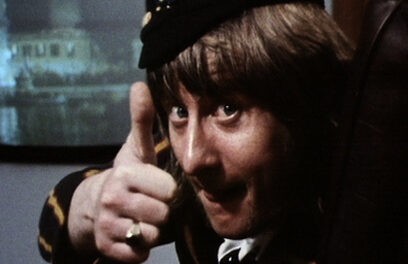After many happy years basking in its warm, electronic glow, my once-reliable television set recently emitted its final diodes of light. An ominous dark patch in the upper left corner of the screen had been growing larger over the past year or so, like some slow but inevitable illness. It seemed to vary in its severity but on particularly bad days it had become difficult if not impossible to decipher what was happening in that area of the image. It had served me well, but clearly it was time for a replacement.
And so, last month I took the plunge and invested in a new smart TV. Like most other home appliances, televisions are what economists call durable consumer goods – items that are designed to last for several years before they are eventually replaced. Indeed, this was the first set I had purchased in almost eight years. Although recent research shows that the average UK consumer replaces their main set every four years, my own octennial rate of replacement means that I probably only have five or six purchases left (life suddenly seems short when you measure it in “television years”). As is probably the case for most readers here, television forms an intimate and integral part of our everyday lives (and livelihoods), yet the actual activity of purchasing hardware is a relatively rare occurrence. As such, I wanted to take this opportunity to reflect on the experience and to consider the degree to which the market for television hardware, and the medium itself, has evolved since I made my last purchase all those years ago.
As a result of how infrequently I buy television hardware, I spent a considerable amount of time researching my ideal set – after all, this purchase would be occupying a prominent place in my living room and family life well into the 2020s. And, if we are to believe the marketing hype surrounding smart TVs, purchasing a new set was also an opportunity to significantly streamline my living room set up which had become so complicated that it required an army of remote controls (and a great deal of technical nous) in order to operate: there was a control for the television, one for the AV receiver, one for the DVR, one for the Blu-ray player, one for a streaming TV box, and two for a games console that rarely gets used.
Every time I fumbled between these controls, sometimes forgetting which input I was actually watching, I would often be reminded of what Henry Jenkins referred to as the “black box fallacy”; an idea that I first encountered in his 2006 book, Convergence Culture: Where Old and New Media Collide, and one that has stuck with me ever since. Jenkins argued, quite rightly judging by my living room set up, that contrary to prevailing discourses at the time about media convergence, ‘there will be no single black box that controls the flow of media into our homes’ (2006:16). If anything, Jenkins’ account suggested that media convergence requires technological divergence in order for it to survive and flourish. Indeed, here we are in 2016, ten years after Convergence Culture was first published, and my hardware still seemed to be diverging at an alarming rate.

A collection of remote controls: a familiar sight for many readers, I’m sure.
My own collection of remote controls might seem excessive, but recent research from Ofcom suggests that I’m not alone. In 2006 – when Jenkins first proposed the black box fallacy – there were only three audio-visual devices that had a penetration rate of at least 20% amongst UK consumers: digital televisions, DVD players, and MP3 players (although it could be argued that Ofcom’s list is somewhat incomplete). By 2015, that number had more than tripled. While some of these newer entries clearly overlap (digital television, smart TV, 3D ready TV), it’s probably safe to assume that most of us have more AV hardware (and remote controls) in our living rooms today compared to a decade ago.

However, a closer look at the Ofcom figures reveals that the penetration rate of many of these audio-visual technologies has either levelled off (in the case of DVRs) or is actually declining (in the case of DVD players and games consoles). We probably shouldn’t read too much into this data but perhaps this is an early sign that the market is heading in a new direction: from hardware divergence to hardware convergence.
Though we should always take advertising with a pinch of salt, the marketing materials that promote smart TVs would suggest that this process of convergence is already well under way. Consider, for instance, all of those sleek and glossy ads in which happy families effortlessly navigate their smart TVs, flicking between every imaginable source at the simple press of a button or the gesture of a hand. To some extent, I bought into this marketing rhetoric and imagined that my new television might finally be the black box that Jenkins’ was so sceptical about. At the very least, it would be my black box, i.e. a device that couldn’t necessarily do everything, just everything that I wanted it to do. It would certainly be a drastic improvement on my current set up in which my recently deceased TV – a “dumb TV” for want of a better term – had acquired all manner of ancillary devices over the years in order to ensure its continued compatibility with the changing landscape of television distribution. Unlike my dumb TV, a smart TV would provide me with access to content via broadcast channels and streaming apps – combining at least two or three of my existing devices into one black box (which would hopefully mean fewer remote controls).
As someone that subscribes to multiple streaming services and who watches almost all of their television on-demand, software ended up playing key role in my decision-making process. I was searching for a set that covered all of the bases so that I would have the freedom to choose between content suppliers. Specifically, I wanted a device through which I could access the “big three” SVOD [subscription video on demand] services: Netflix (for access to exclusive content such as Better Call Saul, House of Cards, Bloodline, Orange is the New Black), Amazon Instant (for Mr. Robot, The Man in the High Castle, Transparent, Mozart in the Jungle) and Now TV (for Mad Men, Boardwalk Empire, Justified, The Walking Dead). I was also looking for a set that would provide me with access to all of the public service and free-to-air streaming services such as the BBC iPlayer, All4 (formerly 4OD), ITV Player, and Demand 5 (well, maybe not Demand 5).
It didn’t seem like this was asking too much – particularly if we are to believe what we see in the promotional materials for smart TVs. Yet as much as I tried, I couldn’t find a television set with the full compliment of on-demand services. It simply doesn’t exist.[1]Though, if readers are interested, my research led me to believe that the Roku 3 (and the soon to be released Roku 4) is probably the most comprehensive device on the market in terms of app … Continue reading My own experience seems to resonate with Chuck Tryon’s account of on-demand culture in which he points out that ‘the introduction of new technologies is often accompanied by utopian promises of greater access, broader political participation, and increased choices. But despite these promises, true choice and mobility are often greatly exaggerated.’ (2013:3) In the case of smart TVs, some manufacturers, such as LG, have a comprehensive selection of SVOD apps (Netflix, Amazon and Now TV) but seemed to be missing a number of the free-to-air catch-up services such as ITV Player and All4. Other manufacturers, such as Sony, had most if not all of the free-to-air services but had a limited selection of the main SVODs. Though it would require further research, I suspect that this inconsistency in terms of access has much to do with complex behind-the-scenes content rights, strategic corporate alliances (and adversaries), as well as the significant costs of producing and maintaining apps for a wide variety of operating systems.

LG’s webOS: Lots of SVOD services but no ITV Player or All4
Ultimately, what I learnt from my recent retail experience is that while technology seems to be converging (with limited success, it should be said), content appears to be heading in the other direction – towards a much more fragmented and complicated marketplace in which access and choice are, as Tryon suggests, greatly exaggerated and in which the promise of “convergence culture” feels like a distant memory. Indeed, as dumb as my last TV was, accessing most if not all of broadcast television used to be a much more straightforward affair. For around £22 a month, I had a basic Sky TV package which included a wide array of channels (excluding most film and all sports networks) as well as a free DVR. With the exception of a short period in which Virgin Media had exclusive rights to a small selection of programming on its now defunct flagship channel, I was able to access most television content (again, with the exception of film and sports).
Today, however, the growing popularity of SVOD services has contributed to the further fragmentation of an already diverse market. And while smart TVs have the capacity to unite all of these different services in one device, it’s unlikely that they ever will (for some of the reasons noted above). As such, the limited availability of apps on smart TVs not only highlights but also reinforces the fragmentation of a market in which access to content is increasingly restricted by the hardware (and the software) that we buy.
By my estimation, it’ll be 2024 before I purchase my next set. And who knows what the market will look like by then.
JP Kelly is a lecturer in film and television at Royal Holloway, University of London. He has published work on the emerging economies of online TV in Ephemeral Media (BFI, 2011) and on television seriality in Time in Television Narrative (Mississippi University Press, 2012). His current research explores a number of interrelated issues including the development of narrative form in television, issues around digital memory and digital preservation, and the relationship between TV and “big data”.
References
| ↑1 | Though, if readers are interested, my research led me to believe that the Roku 3 (and the soon to be released Roku 4) is probably the most comprehensive device on the market in terms of app availability. However, being yet another black box, it somewhat defeats the point of a smart TV. |
|---|





